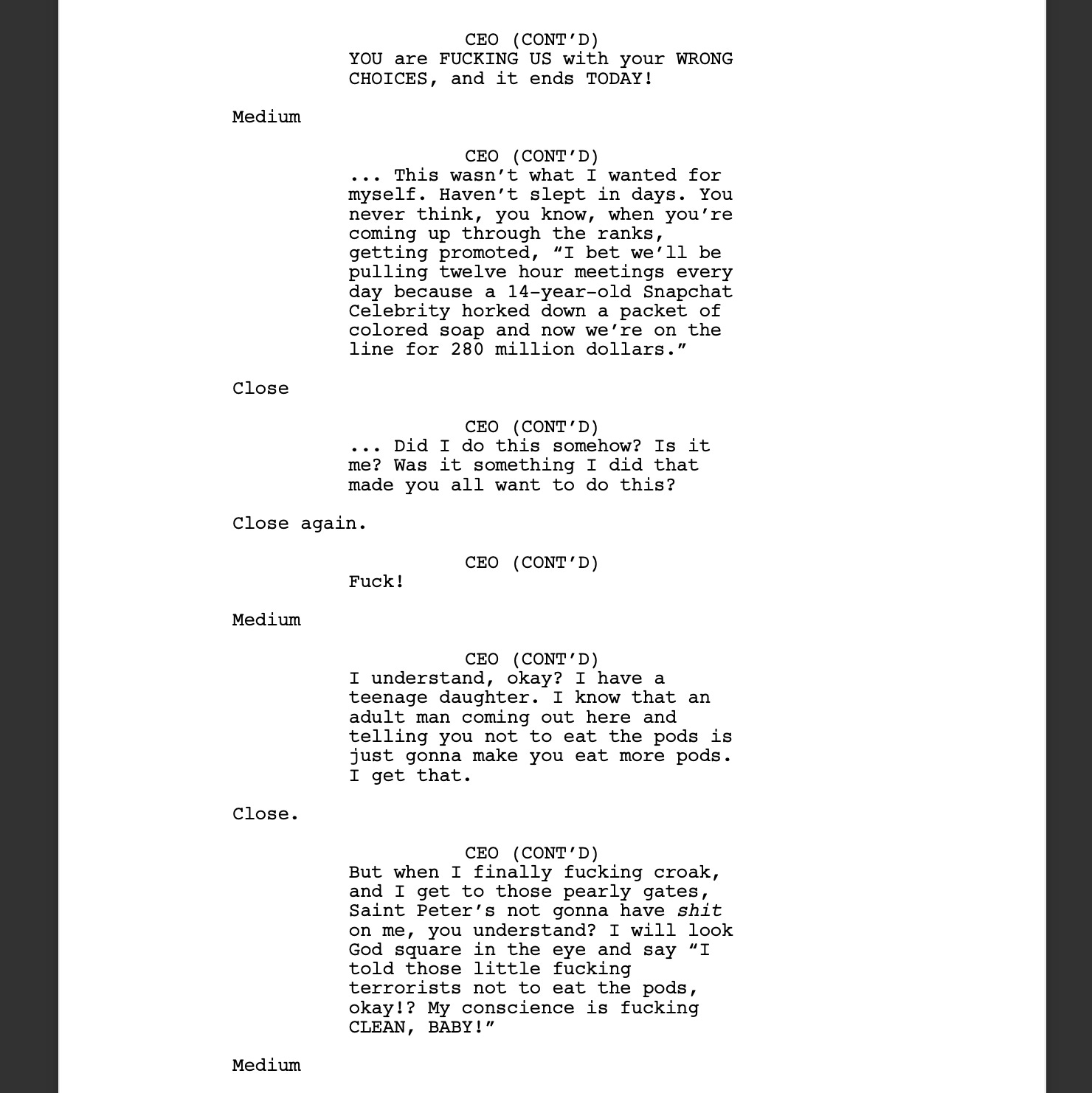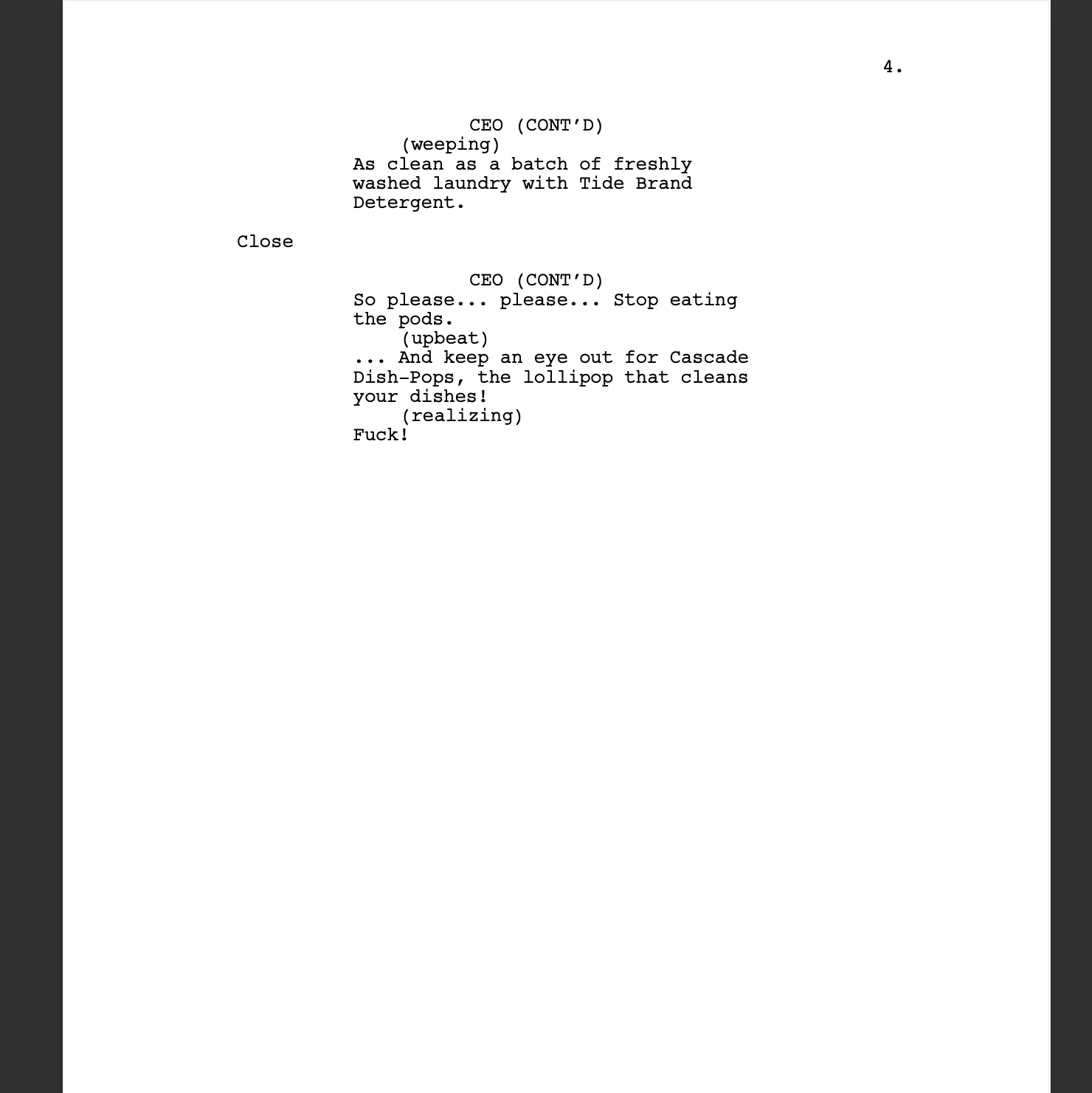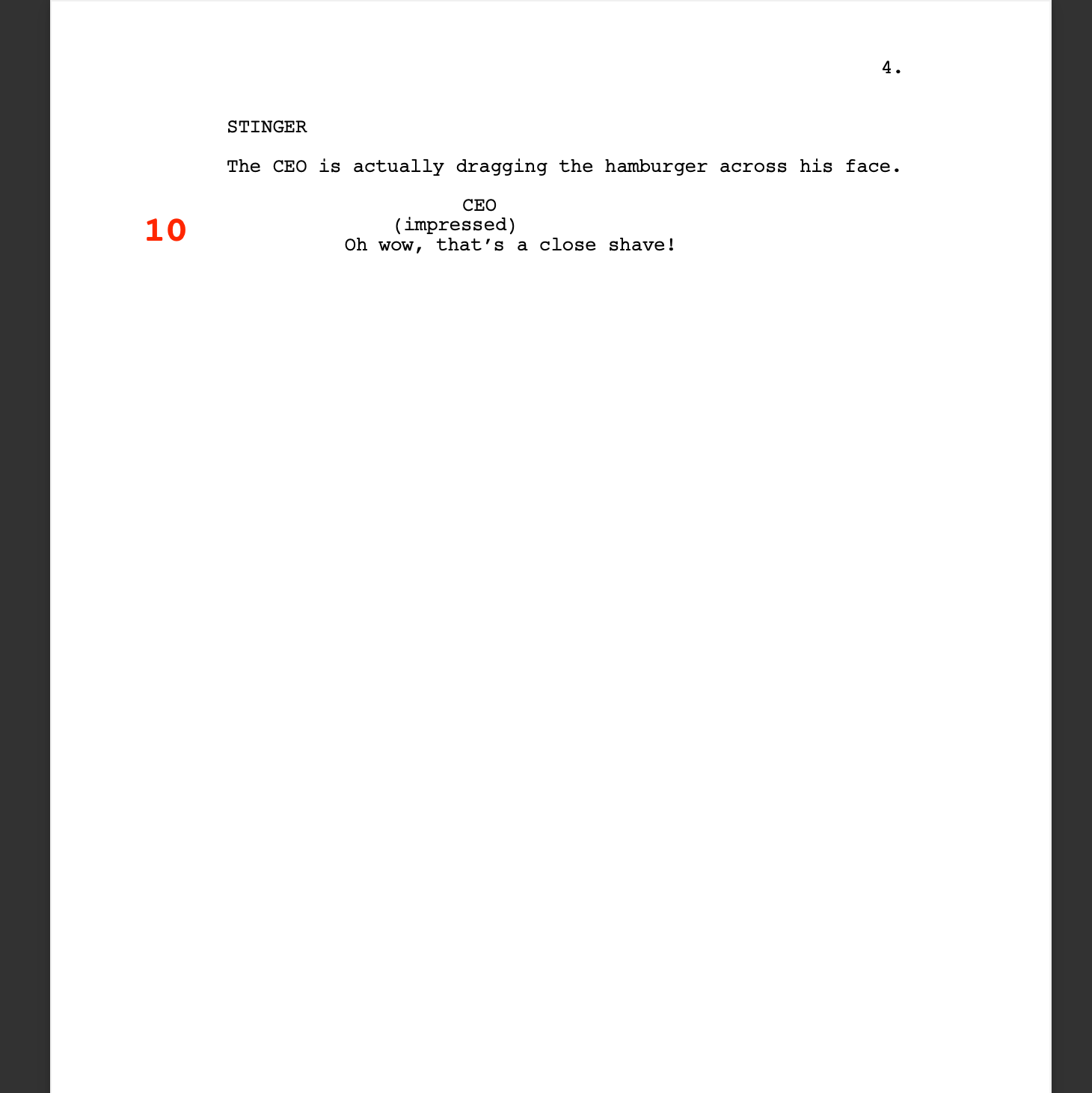Today we have two different versions of the same sketch. Crazy, I know! As a subscriber1 requested, we’re talking about Tide Pod CEO by Brennan Lee Mulligan. We’ve got two versions because Brennan is letting me share the very different, never-before-seen first draft of this sketch.
We’ve talked a bit about what makes a strong game, how to scrutinize funny moments, and how to give notes. I’m leaving the rough draft unmarked. As you read it, assess it as you would anyone’s rough draft. What’s working and what’s not? What notes would you give? What parts of the script do you react to?
Now, if you’ve already seen this sketch, you might already know how it was ultimately changed. That might make it harder to review the rough draft in an unbiased way. Still, poke at it, see what makes you laugh, what surprised you, and what confuses you. After that we’ll do a more thorough dissection of the final draft.
The Rough Draft
Intermission
There’s a lot of great moments in here: colorful turns of phrase, and a delightfully exasperated character. A lot of the comedy as it exists in this draft comes from seeing a straight-laced, boring businessman being forced to confront the mind numbingly stupid idea of a Tide Pod-eating fad. There’s a fun contrast between the head of huge corporation and the tweens who eat his soap as a goof. But there’s also something loose about this script. It feels a little directionless, mostly centered around an exasperated CEO being exasperated. Or in Brennan’s own words:

Brennan calls this game “meh.” Why? If we think back to the two posts on the basics you might recall that sketch is about a single unusual thing heightened to absurdity and that the unusual thing must itself be surprising but true. What is the unusual thing in this draft? You might say it’s the idea of people eating Tide pods… but that’s not heightened to absurdity. That was just real life. You could say that the CEO’s angry reaction is the main focus, but it’s not terribly unusual. We’re missing the unusual element… until the end.2
The last line is heightening. It’s a fun, surprising moment. Here’s a dish soap that looks like a lollipop. It’s bizarre but it makes sense within the logic of the scene. If Tide pods look good to eat, could it be that other P&G products resemble food even more? It’s a great ending, but it makes an even better first beat. If this moment becomes the unusual thing of the sketch, we now have a game that is clearer and easier to play. It’s something like, “Exasperated CEO realizes all his inedible products can be confused for food, just like Tide Pods.”
Knowing this is the game, take a moment to imagine how you might rewrite the sketch with this new angle. How might it heighten? (Again, recognizing that some of you may know exactly where this goes).
The Final Draft
Points of Interest
Cool! I don’t know about you, but this draft feels much better to me. It’s clear what the weird thing is (these inedible products look like food) and it’s also clear what the truth is that makes this relevant (people in real life were treating Tide Pods like food). Everything in this sketch revolves around that idea, yet it also consistently surprises us. The beats feel unexpected but inevitable, surprising but true. It works!
Let’s zoom in and look at exactly what some of these lines are doing.
1. Stage Directions Used to Affect Rhythm
These stage directions are pretty spare. In fact, they’re just different camera angles. If Brennan were writing this script for someone else to perform, it would have been a good idea to include some more detailed description. He could have included some indication of how the CEO’s emotional state is changing, for example. But since Brennan knew he was playing this character this wasn’t strictly necessary. Convenient!
I pointed this out in our last dissection, but notice how the directions here are used to affect the rhythm and readability of the script. These directions break up what would otherwise be one uninterrupted block of dialogue and they mark divisions between beats. They create natural pauses in your mind and let jokes land at appropriate places. Brennan uses specific camera angles, but he could have just as easily had a direction that just said “cut.”
2. The New First Beat
Look! Here it is! What was once the last line of the sketch is now the first beat. And that first beat happens fairly quickly. The CEO introduces himself, introduces the true life inspiration for the sketch (Tide Pods) and establishes his point of view (don’t eat them). That’s pretty much all we need before we introduce the absurd element of the game! And the sketch is moving.
3. Using Camera Cuts to Reset the Game
Remember that sketches rely on an element of repetition. We play the game, we move on, we hit another beat of the game. In many other sketches we’ve looked at we use dialogue to transition us from unusual to normal and back to unusual again. This sketch uses camera cuts instead. This has the advantage of letting us move quickly between beats while also making contrasts more extreme. We’ll get a laugh by cutting from one big emotion to a more subdued delivery, or by cutting from a conversational tone (between the CEO and the director) to a more presentational one (between the CEO and the viewer).
4. Connecting the Heightened Game to the Real World
“No it’s not the same as Tide Pods.”
This is a great line because it’s doing many things at once. It makes the CEO’s point of view clear — this product is not like Tide pods because it doesn’t make sense. But his denial also makes you consider the opposite point of view — this product is the same as Tide Pods because look like candy. It’s a moment that quietly reinforces the game, in case you weren’t quite picking up on the connection.
5. Effective Side Jokes
“What does gum flavored even mean.”
This is a great example of an effective side joke. Does this line need to be in here for the sketch to work? No. But it totally catches you off guard. It’s an extra, unexpected surprise that makes this already insane product just a little more insane. What I love about this is that the first time you hear the phrase “Gum-Flavored Bonbons” just a few lines before, you probably didn’t clock how weird “gum flavored” is. There are so many other things going on it gets a little buried. So when the CEO draws attention to it, it creates one of those comedy moments we’re always aiming for: an unexpected truth. We should have noticed this, but we didn’t, so when someone points out it was in front of us the whole time, we laugh.
6. A Bit of Exploration
This line explores the truthful implications of the game. The sketch follows a predictable pattern: the CEO tries to sell a product, realizes it could be confused for food, reacts to it, we cut to the next product. This bit of exploration, like all moments of exploration, disrupts the pattern but still remains true to the logic of the sketch. It also lets us see more emotions from the CEO than just confusion and anger.
7. An Effective Straightman
Here’s a fun thing you may not have noticed about this sketch — it’s almost all straightman. The unusual things are the products. The CEO is a sane man in an insane world. This is proof, in case you needed it, that the straightman of a sketch can actually be extremely funny. Sometimes they can even be the best part of a sketch. I think that’s the case here. The specific products are funny, but I really enjoy seeing the CEO react to these weird products. His emotional journey, this slow burning rage, is what really pulls me in.
As the straight man, the CEO should be as smart. The audience has probably started to pick up on the pattern, so the CEO should also be aware of the pattern. It’s satisfying to see him cut off his own line to address the fact that this is yet another product that looks like food. It keeps things moving fast, and it keeps the audience from feeling like they’re too far ahead of the sketch. Note, too how this logically changes his emotional state and his tactics. He’s now more angry than confused, which makes sense: he sees what’s happening, but he doesn’t like it.
8. Extreme Heightening
Compare this beat to previous ones. We’re in a whole new level of heightening. Nothing about this product makes sense. It’s a tampon that looks and feels like a popsicle? That’s a terrible tampon and a terrible popsicle. And it’s poison on top of that!
We’re fully in crazy town now. These products seem to exist only to play the game of the sketch, to blur the line between food and household products, to drive this CEO to madness. But we have earned the right to get this crazy because all the other beats have led us here, step by step.
9. The Last Beat
We’re now so heightened there’s no hint of the non-food product here. And it looks nothing like the product it purports to be. And the food isn’t even a processed food. And the impact of this hits hard because it comes across with just an image and three simple sentences.
10. A Reversal As A Tag
A final tag. This kind of ending is a reversal. The CEO who has been thoroughly opposed to every product this entire sketch is, surprisingly, impressed with the most heightened one. This has to be the end. Our beats are as heightened as they can be, and our straightman is now on board with the game. The sketch can’t continue beyond this moment because we played it so hard we broke it. But the point where we broke it gives us one last laugh.
The Final Video
If you want to compare the script to the final video, you can watch that below. Brennan did a lot of improv so there’s more differences than usual between the script and the final cut, but hey, it was his script to change. While you’re watching, note how much camera and editing choices can support a joke. When do we hold on a shot and when do we cut away? When and how does the camera move? How do these things affect the comedy?
Exercises
Think of another beat that fits this game. Where do you think that beat would belong in the sketch, based on how heightened it is?
This second draft is just one way of sharpening the game from the rough draft. What other directions might you go in? Can you think of a different game that could come from the same inspiration?
Hi Damien!
Incidentally, this is not an uncommon problem. Another subscriber described the experience of feeling uncertain what to do in the middle of their sketch. If you know your set up and you know your ending, but you’re unsure what to do in the middle, it could be that your ending is actually your middle, and your real ending is a more heightened beat waiting to be discovered.




















Wow ! This comparison of 1st vs final draft is mind blowing. I don't know why, in my head I was thinking that the final version of the sketch was written like that on the first try by the great almighty Brennan. But I'm thrilled to learn how the team effort made this sketch much better. That's crazy.
That prompts the question : have you sometimes felt that you shouldn't even show a first draft because it's really not good enough ? I feel like that about some things I write, but this post inspires me to say : maybe I should show them anyways and whatever happens... In fact : when is a first draft ready to be shown ? Before this, I was thinking very conservatively about this : never show something you're not already proud of.
Thanks again for the great post.
Thanks to Brennan for sharing these two versions of the script! I love this sketch, and it’s so fascinating to see how it evolved from its original concept.
When trying to think of where I’d possibly add a beat, I was drawn to the joke about the Crest dinner paste. I feel like it could possibly be heightened more to continue the game of inedible products looking edible, while still keeping the joke about how they’re literally just selling food now (which I think is really funny).
Maybe after introducing the food product, he introduces a nearly identical toothpaste product called meal bag FLAVORED toothpaste, which is 100% NOT edible. The CEO holds the two identical tubes up, one that’s edible and one that isn’t, and doesn’t understand how no one can see that this is an accident waiting to happen. (Or maybe it would work better if the inedible toothpaste was introduced first? I couldn’t decide which version would be best, if the added joke even works at all.)